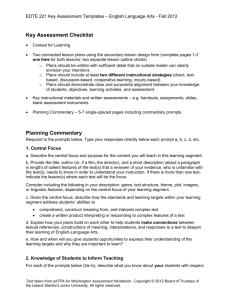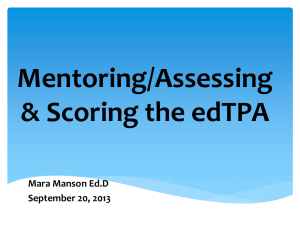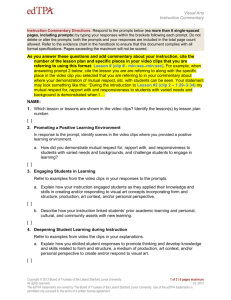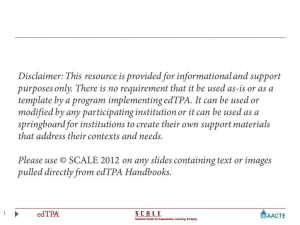edTPA REQUIREMENT FOR LICENSURE
advertisement
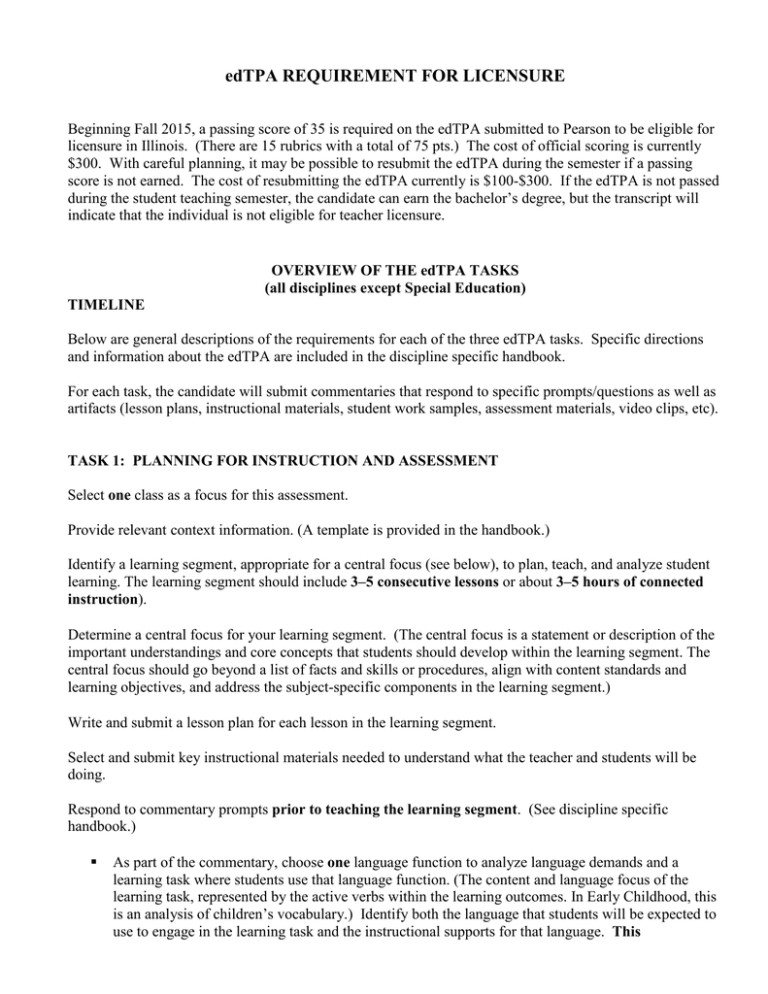
edTPA REQUIREMENT FOR LICENSURE Beginning Fall 2015, a passing score of 35 is required on the edTPA submitted to Pearson to be eligible for licensure in Illinois. (There are 15 rubrics with a total of 75 pts.) The cost of official scoring is currently $300. With careful planning, it may be possible to resubmit the edTPA during the semester if a passing score is not earned. The cost of resubmitting the edTPA currently is $100-$300. If the edTPA is not passed during the student teaching semester, the candidate can earn the bachelor’s degree, but the transcript will indicate that the individual is not eligible for teacher licensure. OVERVIEW OF THE edTPA TASKS (all disciplines except Special Education) TIMELINE Below are general descriptions of the requirements for each of the three edTPA tasks. Specific directions and information about the edTPA are included in the discipline specific handbook. For each task, the candidate will submit commentaries that respond to specific prompts/questions as well as artifacts (lesson plans, instructional materials, student work samples, assessment materials, video clips, etc). TASK 1: PLANNING FOR INSTRUCTION AND ASSESSMENT Select one class as a focus for this assessment. Provide relevant context information. (A template is provided in the handbook.) Identify a learning segment, appropriate for a central focus (see below), to plan, teach, and analyze student learning. The learning segment should include 3–5 consecutive lessons or about 3–5 hours of connected instruction). Determine a central focus for your learning segment. (The central focus is a statement or description of the important understandings and core concepts that students should develop within the learning segment. The central focus should go beyond a list of facts and skills or procedures, align with content standards and learning objectives, and address the subject-specific components in the learning segment.) Write and submit a lesson plan for each lesson in the learning segment. Select and submit key instructional materials needed to understand what the teacher and students will be doing. Respond to commentary prompts prior to teaching the learning segment. (See discipline specific handbook.) As part of the commentary, choose one language function to analyze language demands and a learning task where students use that language function. (The content and language focus of the learning task, represented by the active verbs within the learning outcomes. In Early Childhood, this is an analysis of children’s vocabulary.) Identify both the language that students will be expected to use to engage in the learning task and the instructional supports for that language. This requirement does not apply to World Language candidates. Submit copies of directions for all planned assessments from the learning segment. (Consider conducting a pre-assessment on the first day and a post-assessment on the last day of the learning segment.) TASK 2: INSTRUCTING AND ENGAGING STUDENTS IN LEARNING Obtain required permissions for videorecording from parents/guardians of the students and other adults appearing in the video. Identify lessons from the learning segment planned in Task 1 to videorecord. Choose lessons that show interaction with students and engaging them in learning. (It is important to videotape all lessons of the learning segment.) Videorecord all lessons of the learning segment and select 1 or 2 video clips. (The discipline specific handbook will specify the number and length of these unedited clips.) Analyze teaching and students’ learning in the video clips by responding to commentary prompts. TASK 3: ASSESSING STUDENT LEARNING Select one assessment from the learning segment that will use to evaluate your students’ developing knowledge and skills. (This could be the post-assessment.) Attach the assessment used to evaluate student performance at the end of the Assessment Commentary. Define and submit the evaluation criteria that will be used to analyze student learning. Collect and analyze student work/sources of evidence from the selected assessment to identify quantitative and qualitative patterns of learning within and across learners in the class. Select 2-3 student work samples (see the discipline specific handbook for details) to analyze patterns of learning within and across learners in the class. At least one of the samples must be from a student with specific learning needs. These 2-3 students will be the focus students. Summarize the learning of the whole class, referring to work samples from the 2-3 focus students to illustrate patterns in student understanding across the class. Submit feedback for the work samples for the 2-3 focus students in written, audio, or video form. Analyze evidence of students’ language use from (1) the video clips from the Instruction task, (2) an additional video clip of one or more students using language within the learning segment, AND/OR (3) the student work samples from the Assessment task. This requirement does not apply to World Language candidates. Analyze evidence of student learning and plan for next steps by responding to commentary prompts. 7/1/15
